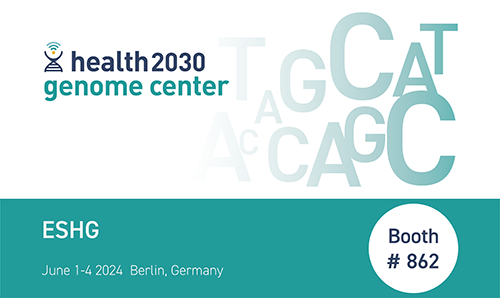Information for Customers
The whole genome sequencing, whole exome sequencing, and RNA-seq services of the DNA Sequencing Platform of the Health 2030 Genome Center are ISO 15189:2013 accredited by the Swiss Accreditation Society (accreditation number SMTS 0050). Important details of these services, including Customer Service Agreements and sample requirements, preparation, naming, and submission, are described below.
CERTIFICATES
English - French - German - Italian
SCOPE OF SERVICES
The Accredited DNA Sequencing Services provided by the Health 2030 Genome Center are solely based on receiving already isolated and purified nucleic acids from physicians, medical diagnostic services, or scientists who are authorized to analyze patient samples. The Genome Center has absolutely no direct interactions or contact with patients: it does not meet with patients, nor does it take, collect or receive samples directly from patients. Furthermore, the Health 2030 Genome Center does not provide either physicians or patients the diagnostic or clinical interpretation of the data it generates. Physicians/medical diagnostic services/scientists provide the Genome Center with the nucleic samples to analyze, the Accredited DNA Sequencing Service processes the samples to generate nucleic acid sequence data, and those data are provided back to the physicians/medical services/scientists who then perform the diagnostic or clinical interpretation.
DETAILS OF THE ACCREDITED SEQUENCING SERVICES
WGS
Human Whole Genome Sequencing (WGS) based on Illumina PCR-free library preparation and Illumina sequencing. Genomic DNA samples submitted for WGS will be QC checked both by fluorescence-based quantification and sample integrity, processed using the indicated library preparation reagents, and sequenced on the Illumina sequencing platform.
WES
Human Whole Exome Sequencing (WES) based on Twist/IDT exome capture library reagent and Illumina sequencing. Genomic DNA samples submitted for WES will be QC checked both by fluorescence-based quantification and sample integrity, processed using the indicated library preparation reagents, and sequenced on the Illumina sequencing platform.
RNA-seq
Human full transcriptome RNA-seq based on Illumina TruSeq Stranded mRNA-seq library reagents and Illumina sequencing. Total RNA samples submitted for WGS will be QC checked both by fluorescence-based quantification and sample integrity, processed using the indicated library preparation reagents, and sequenced on the Illumina sequencing platform.
DELIVERABLES
The standard delivery for each processed sample contains a FASTQ file and a delivery report with corresponding quality metrics. Delivery of any additional information or other data formats shall be discussed and agreed upon between the Customer and the Genome Center prior to initiation of the project.
We recommend sending the samples at the beginning of the week and avoiding weeks with public holidays to minimize the risk associated with delivery delays.
SAMPLE REQUIREMENTS (see also FACTORS INFLUENCING DNA AND RNA QUALITY at the bottom of this page)
WGS
- 2 ug of gDNA in 50ul 10mM Tris (8.0)
- DNA concentration MUST be determined by PicoGreen (or equivalent)
- DQN/DIN value >8
- Sample OD260/280 absorbance values should be greater
- Users will be contacted when samples do not meet the minimum required QC standards. Samples that do not meet the Genome Center minimum requirements may still be processed for sequencing, but in these cases, the Genome Center takes no responsibility for sub-optimal results.
WES
- 300ng of gDNA in 50ul 10mM Tris (8.0)
- DNA concentration MUST be determined by PicoGreen (or equivalent)
- DQN/DIN value >8
- Sample OD260/280 absorbance values should be greater
- Users will be contacted when samples do not meet the minimum required QC standards. Samples that do not meet the Genome Center minimum requirements may still be processed for sequencing, but in these cases, the Genome Center takes no responsibility for sub-optimal results.
RNA-seq
- 500ng of total RNA in 50ul water or 10mM Tris (8.0)
- RNA concentration MUST be determined by the RiboGreen method (or equivalent)
- RQN/RIN value >7
- Sample OD260/280 absorbance values should be greater equal to or greater than 1.9
- Users will be contacted when samples do not meet the minimum required QC standards. Samples that do not meet the Genome Center minimum requirements may still be processed for sequencing, but in these cases, the Genome Center takes no responsibility for sub-optimal results.
SAMPLE ALIQUOTING & NAMING
Sample tubes
DO NOT SEND SAMPLES IN INDIVIDUAL TUBES. The Genome Center provides users with barcoded sample tubes for sample submission. These tubes MUST be used as they have been chosen to be compatible with our LIMS and sample-tracking protocols. Contact the Genome Center to organize the delivery of these tubes when you are ready for sample submission.
Sample naming
When naming samples, use ONLY upper- and lower-case English letters from "a" to "z", numbers from 0 to 9, and the special character "_" (underscore). If you use other characters, we will ask you to reformat your sample names.
DO NOT INCLUDE ANY PATIENT IDENTIFICATION INFORMATION IN THE SAMPLE NAME
SAMPLE SHIPPING
Transportation of sample to Genome Center
Genomic DNA samples should be sent to the Genome Center at room temperature in 96-well sample plates. Contact the Genome Center for detailed instructions. Samples MUST be sent to the Genome Center according to these instructions.
Total RNA samples should be sent to the Genome Center on dry ice in 96-well sample plates. Contact the Genome Center for detailed instructions. Samples MUST be sent to the Genome Center according to these instructions.
All sample shipments should be addressed to:
DNA Sequencing Platform
Health 2030 Genome Center
Campus Biotech
9 Chemin des Mines
CH-1202 Geneva, Switzerland
USER AGREEMENT AND PROJECT DISCUSSION
To initiate a discussion of a service project, please send an email to customer@health2030.ch as Service projects are governed under the conditions described in an agreement (customer service agreement) between the user and the Genome Center signed by both parties before initiating the project.
USER FEEDBACK
To initiate a discussion of a service project, please send an email to customer@health2030.ch as Service projects are governed under the conditions described in an agreement(customer service agreement) between the user and the Genome Center signed by both parties before initiating the project.
Factors Influencing DNA and RNA Quality
General Considerations
The quality of the nucleic acids submitted to the Genome Center - i.e., the integrity and purity of the RNA and DNA – is critical to the quality of the sequencing results. Efforts should be made to preserve the integrity of the DNA and RNA in the sampled tissue, minimize the possibility of any chemical modifications, and avoid any agents that could contaminate nucleic acid samples (e.g., unrelated cell or tissue types, presence of DNA in RNA samples) or inhibit downstream enzymatic manipulations (e.g., residual proteins, chemical reagents).
General factors that can have a significant impact on nucleic acid yield, integrity, and purity:
- Biological sample collection buffer and tubes. Nucleic acid source tissues and cells should be collected using tubes and media appropriate for the tissue type and subsequent isolation protocol (e.g., EDTA/anticoagulant solution to collect blood samples for DNA isolation).
- Time from biological sample (e.g., blood, buccal swab, cell culture, etc.) ‘harvest’ to nucleic acid extraction. This time should be minimized to the greatest extent possible.
- Conditions of biological sample storage prior to nucleic acid extraction. If it is not possible to immediately perform the nucleic acid extraction, biological samples should be stored until processing at -80˚C and thawed only prior to processing according to the instructions provided by the manufacturer of the nucleic acid purification reagents. The time to reach storage temperature should be minimized as much as possible, for example, by flash freezing of tissues in liquid nitrogen prior to storage at -80˚C.
- Isolation and purification protocol and reagent kits. In all cases, approved commercial or well-validated in-house DNA and RNA isolation protocols should be used, strictly following the instructions supplied by the provider. The yield, integrity, and purity of isolated RNA or DNA samples should be evaluated by electrophoresis, spectrophotometry, and fluorometry.
- Nucleic acid isolation from formalin-fixed tissue samples. Preparation of high-quality RNA and DNA can be a challenge when working with formalin-fixed, paraffin-embedded (FFPE) samples due to protein-nucleic crosslinks caused by the fixation process. Furthermore, the nucleic acid damage caused by fixation increases with time during storage. Due to the risk of nucleic acid degradation, the use of FFPE samples should be avoided if possible.
- Apoptotic or necrotic cells. Apoptotic or necrotic cells produce very degraded nucleic acids. Tissue samples that are primarily apoptotic or necrotic cells will produce very poor quality nucleic acid samples; tissue samples that are a mixture of live cells and apoptotic or necrotic cells can produce difficult to analyze samples that are a mixture of high quality and very degraded DNA or RNA.
- Sample mosaicism or heterogeneity. Inclusion of cell populations that are not targeted in sampling (e.g., neighboring normal cells in a tumor sample, bacteria in saliva samples, etc.) can result in multiple nucleic acid profiles being present in the nucleic acid sample. This can impact the generation of the sequencing data, complicate the analysis of the sequencing data and obscure the results. Importantly, this concern does not apply in cases of genetic mosaicism, where more than one set of genetic information is present within the sampled tissue.
- Inhibiting chemical agents. Isolated nucleic acid must be free of contaminating chemical agents (e.g., phenol, other reagents) and other biological molecules (e.g., proteins, lipids, pigments) that might inhibit downstream analytical processes.
RNA-specific Considerations
- RNA can degrade rapidly during collection and processing if the biological sample is not handled with proper care. In addition, RNases are abundant in the environment (including hands and lab surfaces). Therefore, to maintain the quality of the RNA sample, the following precautions should be considered:
- Chemically stabilize RNA by immediate storage of the source sample in a stabilization agent (e.g., RNAlater or RNAprotect)
- Careful handling of samples, strict adherence to the extraction and purification protocols provided by the manufacturer, and good aseptic techniques are required (working on ice, e.g., use of RNAse free microcentrifuge tubes and pipette tips)
- Removal of RNases from laboratory surfaces and equipment by treatment with RNAse decontamination solution (e.g., RNaseZap or RNase AWAY)
- RNA sample contamination by genomic DNA. The presence of residual genomic DNA in RNA samples can result in inaccurate quantification and interfere with downstream sample processing and analysis. Therefore, removal of residual genomic DNA by DNAse treatment of RNA samples is recommended.
RNA and DNA Storage Conditions
- DNA: Short- to medium-term storage of purified genomic DNA should be done at -25˚ C; long-term storage of purified genomic DNA should be done at -80˚ C.
- RNA: storage of RNA should be done at -80˚C.



